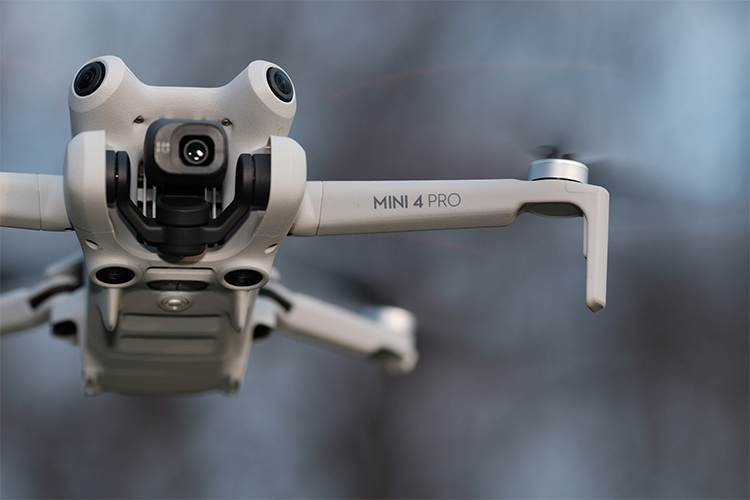With the launch of the Mini 4 Pro, DJI has perfected the recipe for making premium ultra-lightweight drones. It comes just 18 months after the excellent Mini 3 Pro, but with significant improvements in image processing and obstacle avoidance technology, it’s undeniably the one to beat.
Weighing in at under 250 grams, it’s not subject to many of the rules and regulations that apply to larger models. In the US, it doesn’t need to be registered with the FAA for recreational use, while in the UK (a notoriously difficult country to fly drones in) it can be flown pretty freely in public areas. Phew.
Here in the UK, finding a drone that weighs under 250 grams is crucial for most amateur pilots. What’s the point of spending money on a high-performance camera drone like the DJI Mavic 3 (895g) or the newer DJI Air 3 (720g) if I risk breaking the law every time I take off? There’s usually a big trade-off here, though, as the quality of the camera and safety features decreases as the drone gets smaller and lighter. Thankfully, the Mini 4 Pro doesn’t feel anywhere near subpar in these areas—even if it doesn’t quite reach the performance heights of its bigger brothers.

Safety First
With up to 34 minutes of flight time on a full charge, the DJI Mini 4 Pro has the same battery life as the Mini 3 Pro. I think that’s a generous amount of time, even if the actual flight time is closer to 25 minutes than 34. However, anyone expecting long days of shooting without an easy way to charge it would do well to invest in an extra battery or two (they cost about $65 each).
You can also just buy the DJI Fly More bundle ($1,159), which includes the drone, three batteries, a charging dock for all three batteries, an RC 2 controller, and a durable shoulder bag to carry everything. This is the version of the drone I received for testing, and while it’s expensive, it feels like a one-time purchase. It’s also worth noting that the RC 2 controller is one of the best I’ve ever used.
Like most consumer drones, the Mini 4 Pro is flown using a classic twin-stick control method. It’s easy to master—especially since much of the work is now done for you by automatic takeoff and landing—and impressively responsive.

Even as a relatively experienced pilot, I love how difficult it is to crash a DJI drone. This is thanks to its full omnidirectional vision sensor array, which in drone jargon means sensors facing forward, backward, down, up, and to either side. It’s the first time this kind of disaster avoidance technology has been used on an ultralight DJI drone, and I’m excited. If the Mini 4 Pro detects an impending collision, it will immediately stop in the sky. You’ll struggle to even intentionally crash this drone, and that’s exactly how it’s supposed to be.
These sensors also allow the drone to avoid obstacles when using its autopilot-like ActiveTrack 360 system. Simply draw a box around an object – a boat or car, for example – on the controller’s touchscreen and the Mini 4 Pro will autonomously follow it as it moves, keeping it in the camera frame. I found it useful for getting cinematic footage of myself riding a bike and also, impressively, keeping up with a speedboat through the wake, and it was reassuring to know that the Mini 4 Pro had the smarts to stay safe while tracking.
However, the vision system is not completely foolproof. This won’t work if you fly the drone in the fastest and most responsive sport setting. That’s fine, but you need to be extra careful after dark.
Night shots
But it’s worth brushing up on your sunset flying skills, thanks to the significant improvements to the gimbal-stabilized camera. The Mini 4 Pro has the same 48-megapixel 1/1.3-inch Quad Bayer image sensor as the Mini 3 Pro, but the processing has been significantly improved. It now matches the 4K/60fps performance of the Mini 3 Pro, but can also shoot super-smooth slow motion in 4K at 100fps.
Even better, it now has the option to record 10-bit D-Log-M video, which offers greater grading potential in post-production. I’m still learning about color grading and correcting drone footage, but I was able to turn my 10-bit aerial footage into something really dynamic and exciting. It’s definitely the best footage I’ve ever seen from an ultralight drone, even if it doesn’t quite match the level of detail of the larger sensors on the DJI Mavic 3 or Air 3.

The Mini 4 Pro also offers dual native ISO and a new Night Mode for better video quality in low light, but in reality, what you can do is limited with such a small sensor. Nighttime clarity is certainly a step up from the Mini 3 Pro, but it can’t avoid a touch of streaking and noise in the darker areas.
It’s also worth mentioning that the camera can be rotated 90 degrees to film vertical content like TikTok and Instagram Reels. It’s a clever trick, and while I personally find the concept of a long 9:16 drone video completely alien, I can imagine others might enjoy the added versatility.
Less is more
For me, the Mini 4 Pro is the first sub-250g drone that doesn’t feel like a huge compromise. That’s not to say DJI’s previous ultralight efforts were bad – and it’s worth noting that no rival brand can currently match DJI – but compared to the larger, more expensive models in the Air or Mavic range, I would definitely have felt like I was missing out.
But remarkably, that’s not the case with the Mini 4 Pro. Of course, it’s not quite as good as an Air 3 or Mavic 3 camera-wise, but it comes close enough that that FOMO isn’t felt as strongly. I’d happily choose a Mini 4 Pro as my everyday drone for aerial photography and video. It’s effortless and safe to fly, easy to carry, can be flown legally almost anywhere, and its camera produces fantastic results.


Add a Comment